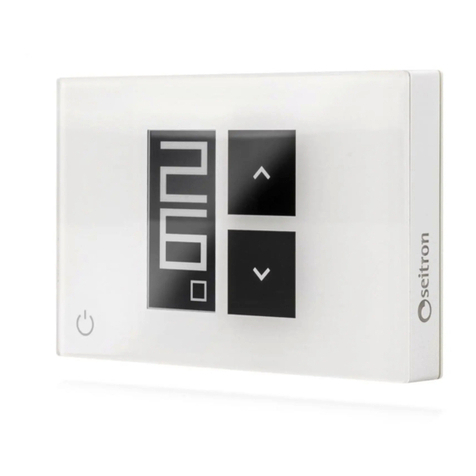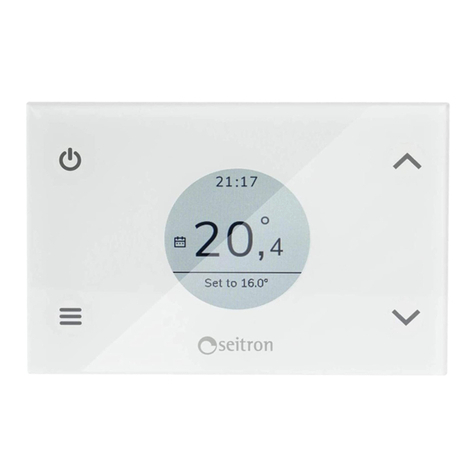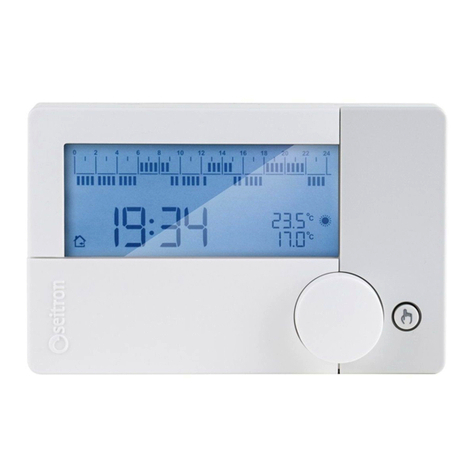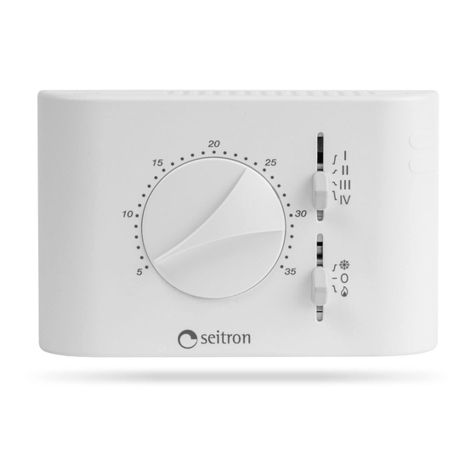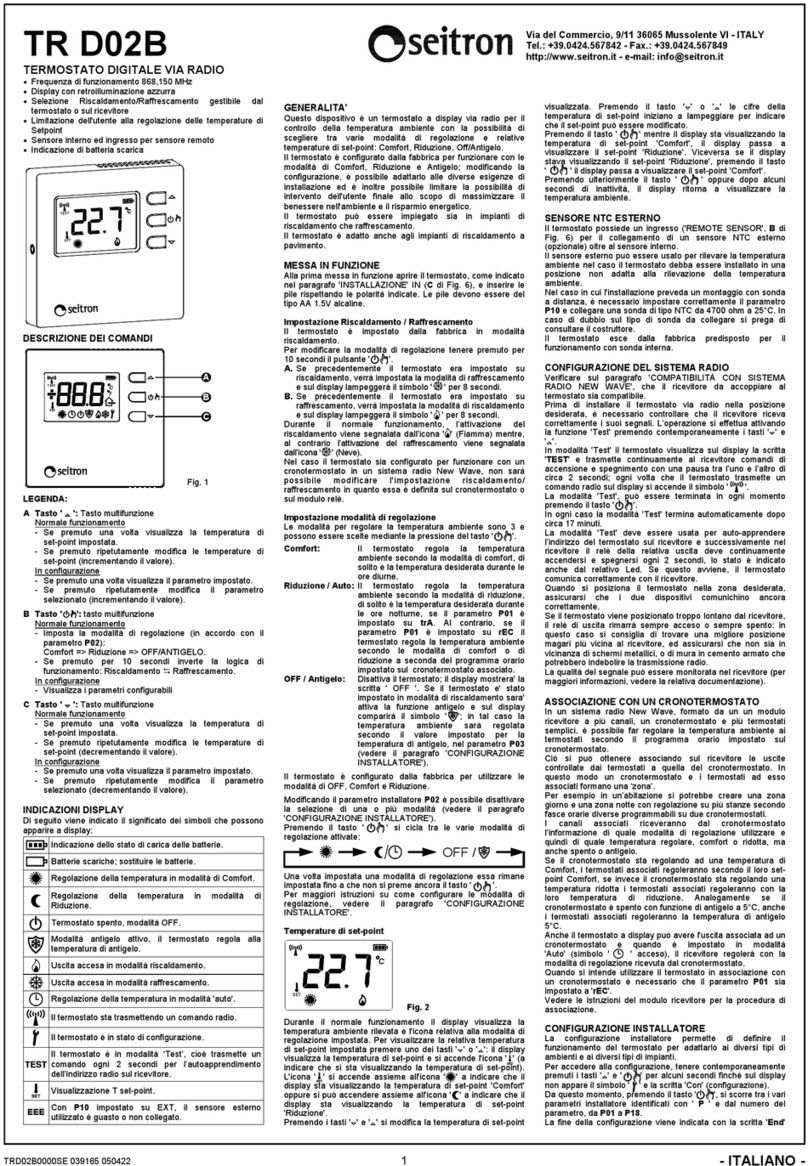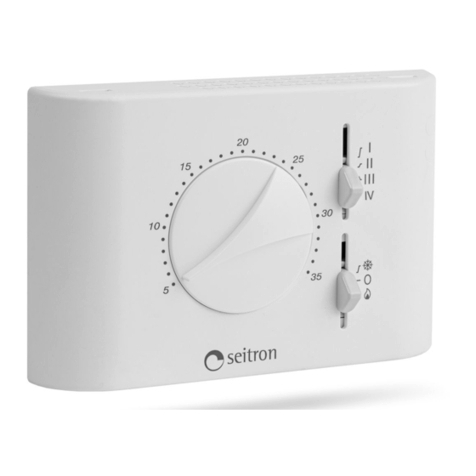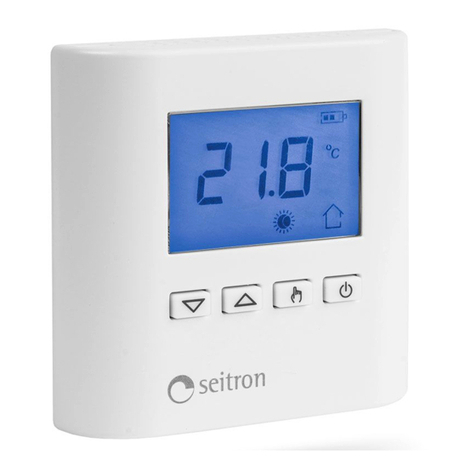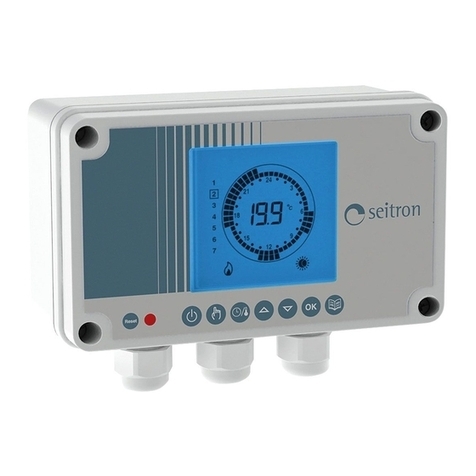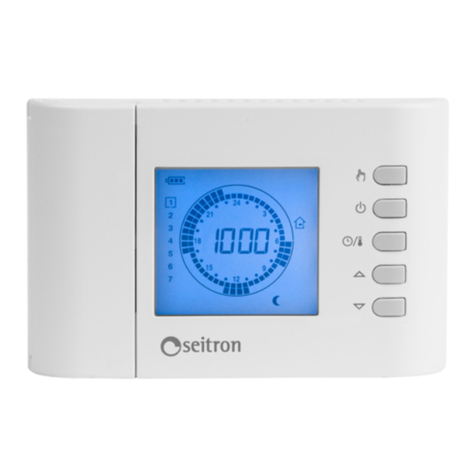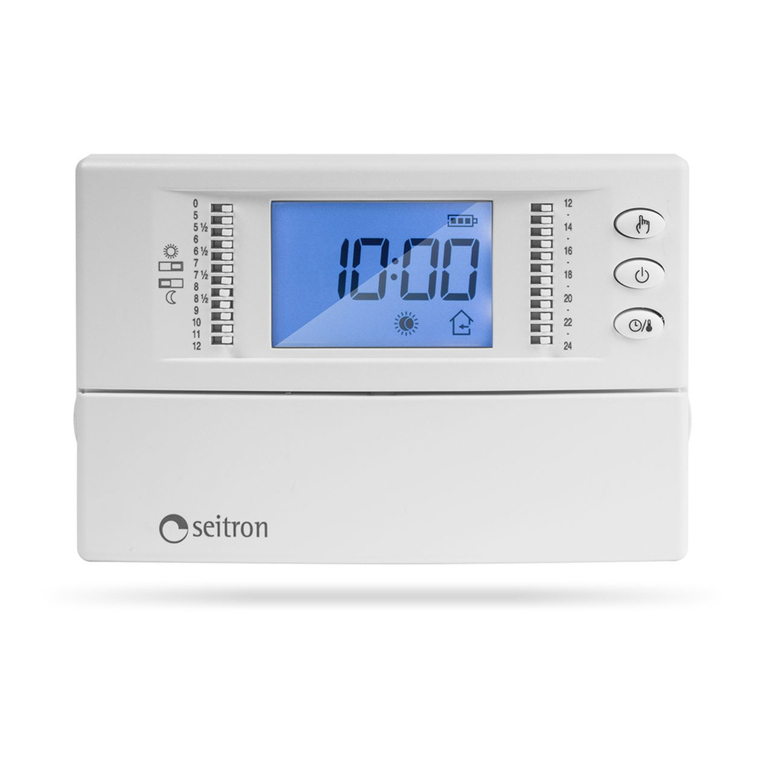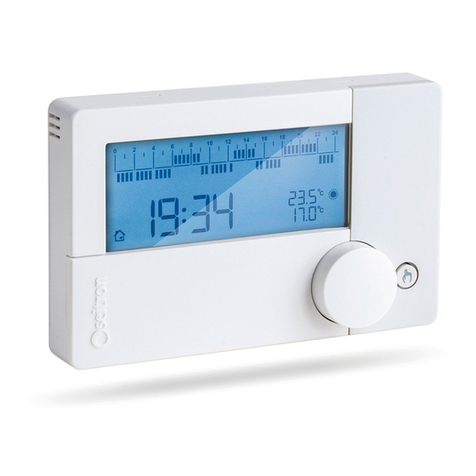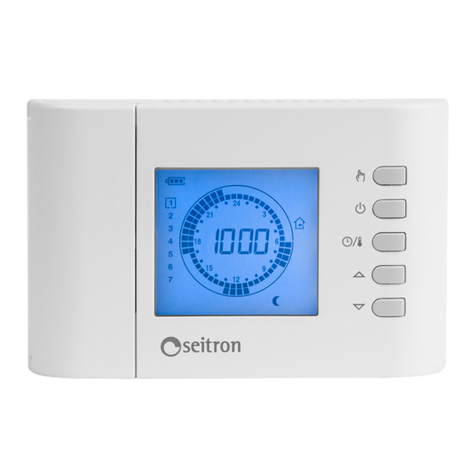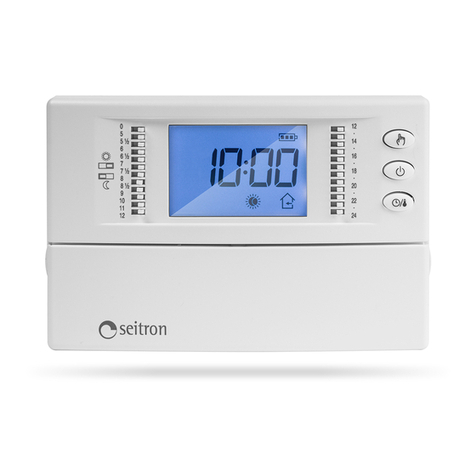
- ENGLISH -
TRD03B0000SE 036247 270121
Full batteries life.
Low batteries life; need replacement.
Temperature set in Comfort mode.
Temperature set in Economy mode.
Thermostat switched off, OFF mode.
Active antifrost mode, the thermostat sets to antifrost
temperature.
Heating mode output.
Cooling mode output.
The thermostat has sent a radio command.
The thermostat is under configuration.
The thermostat is in 'Test' mode, and it transmits a
command every 2 seconds for the pairing procedure
of a receiver.
T set-point displayed.
EEE If P09 is set on EXT, the utilized external sensor is
faulty or unplugged.
OVERVIEW
This device is a radio-controlled display thermostat to control
the room temperature with the option to choose among different
setting modes and related set-point temperatures: Comfort,
Economy, Off/Antifrost.
The thermostat is set by default to operate in Comfort,
Economy and Antifrost modes; it can be adapted to the
different installation requirements by modifying the settings and
the final user intervention can be restricted, aiming to optimize
environment comfort and energy saving. The thermostat can be
used in both heating and cooling systems and it is also suitable
for floor heating systems.
START-UP
When activating for the first time, open the thermostat cover, as
shown in paragraph 'INSTALLATION' in (Cof Fig. 6), and insert
batteries with the correct polarity. Batteries shall be 1.5V
alkaline AA type.
Heating/Cooling Set-up
The thermostat is set by default in heating mode.
Hold down ' ' for 10 seconds to modify the regulation mode.
A. Cooling mode will be set if the thermostat was previously set
on heating and the symbol ' ' will flash on display for 8
seconds.
B. Heating mode will be set if the thermostat was previously set
on cooling and the symbol ' ' will flash on display for 8
seconds.
The lit icon ' ' Flame indicates that heating mode is on during
normal operation; on the contrary, cooling activation is signalled
by the Snow icon ' '.
Regulation mode set-up
There are 3 ways to set the room temperature that can either
be selected by pressing ' '.
Comfort: The thermostat sets the room temperature in
comfort mode; this is normally the preferred
temperature during the day-time.
Economy: The thermostat sets the room temperature
according to the economy mode (this is
usually the preferred temperature during
night time).
OFF / Antifrost: Turn off the thermostat; the display will show
the text 'OFF'. If the thermostat was set to
heating mode and the antifreeze function is
active, the icon ' ' will appear on the
display; in this case the room temperature
will be regulated according to the value set
for the antifreeze temperature, in parameter
P02.
(see paragraph 'INSTALLER CONFIGURATION').
The thermostat is set by factory default to use OFF, Comfort
and Economy modes.
Through the installer parameter P01 it is possible to deactivate
the option to select one or more functions (see the 'INSTALLER
CONFIGURATION' paragraph).
Pressing ' ' cyclically scroll among the different activated
setting modes:
Once a setting mode is set, it remains so until the ' ' key is
pressed again.
See the 'INSTALLER CONFIGURATION' paragraph for further
information on how to configure the setting modes.
Set-point Temperature
Fig. 2
During normal operation the display shows the room
temperature detected and the icon for the selected operating
mode. In order to show the relevant set-point temperature
press any of the keys '' or '': the display will show the set-
point temperature and the icon ' ' will turn on (thus showing
that the value shown refers to the set-point temperature).
The icon ' ' turns on along with icon ' ' thus meaning that the
display is showing the ‘Comfort’ set-point temperature or as an
alternative, together with icon ' ' thus meaning that the display
is showing the ’Economy’ set-point temperature.
Pressing the key '' or '' results in modifying the current set-
point temperature. By pressing the key '' or '' the set-point
temperature digits start flashing to point out that the set-point
can be changed.
Pressing the key ' ' while the display is showing the
‘Comfort’ set-point temperature results in switching to the
‘Economy’ set-point display.
On the other hand when the display shows the 'Economy' set-
point pressing the ' ' key results in showing the 'Comfort'
set-point.
A further pressing of the ' ' key results in showing the room
temperature, as well as after a few seconds of inactivity on the
keys.
EXTERNAL NTC SENSOR
The thermostat features an input ('REMOTE SENSOR', Bin
Fig. 6) to connect an external NTC sensor (optional)
alternatively the internal one.
The external sensor can be used to measure the room
temperature when the thermostat is installed in a position which
does not allow a correct room temperature measurement.
When the installation requires an installation with a remote
sensor, it is necessary to set correctly the parameter P09 and
connect a 10 kOhm @ 25°C NTC sensor. If there is any doubt
about the type of sensor to be connected, please consult the
manufacturer.
The thermostat leaves the factory already set to operate with
the internal sensor.
RADIO SYSTEM CONFIGURATION
Check on the paragraph 'COMPATIBILITY WITH
BIDIRECTIONAL WIRELESS SYSTEM', that the receiver to be
paired with the thermostat is a compatible one.
Check if the receiver correctly receives the wireless thermostat
signals before installing the latter in the desired position. The
operation is performed by activating the 'Test' function by
simultaneously pressing '' and '' buttons.
The thermostat displays the icon 'TEST' and continuously
transmits switch-on and off controls to the receiver, with a 2
second pause between them, in 'Test' mode; every time the
thermostat transmits a radio command and only if it receives an
acknowledgment from the receiver, the symbol ' ' lights up
on the display. The 'Test' mode can be interrupted at any time
by pressing ' '. However, the 'Test' mode automatically
ends after approx.17 minutes.
'Test' mode must also be activated to pair a receiver to the
thermostat, this procedure allows the devices to exchange and
memorize their address which will allow them to recognize each
other. In 'Test' mode, in addition to the text 'TEST', the display
will also show 'nd1' or 'Ed1':
nd1: new device 1 - if no receiver has ever been paired.
Ed1: existing device 1 - if a receiver has already been paired.
To pair a receiver with the thermostat, activate the pairing
procedure on the receiver by pressing the relevant button, after
about 10 seconds, if the operation is successful, the thermostat
will confirm the pairing with the text dL1: device learned 1 after
a few moments the thermostat in 'Test' mode will return to
display Ed1: existing device 1 the receiver will also confirm the
successful pairing, with an alternating red-green-red-green
flashing of the LED.
Once paired, the receiver will begin to receive the Test
commands sent by the thermostat and the relay of its output
must continuously switch on and off every 2 seconds, the
status is also indicated by the relevant LED. If the receiver has
no output relay, the LED will flash green at each reception of
the Test command. Observe the LED on the receiver to confirm
that the thermostat is communicating correctly with the
receiver. Correct communication with the receiver can also be
checked on the thermostat: the ' ' symbol lights up on the
thermostat display for a few moments each time the thermostat
receives an acknowledgment command from the receiver. It is
possible to pair more receivers to the same thermostat up to a
maximum of 6. During the Test mode, by pressing the '' or ''
it is possible to select nd2 (new device 2) to nd6 (new device
6) and perform a pairing procedure for each additional receiver.
During the 'Test' mode the thermostat will send commands and
will receive acknowledgment only from the selected receiver in
order to check the correct communication with each single
paired receiver.
Make sure that the two devices still correctly communicate
when positioning the thermostat in the destination area.
The output relay always remains on or off if the thermostat is
positioned too far from the receiver: if so, we recommend to
find a better position, possibly closer to the receiver, and
ensure it is not near metal screens or reinforced concrete walls
that might weaken radio transmission.
The signal quality can be checked with the receiver (see the
relative documentation for further information).
CANCELLATION OF A RECEIVER
In case you have paired the wrong receiver, or need to replace
a receiver, it is necessary to cancel the pairing between the
thermostat and the receiver.
The cancellation procedure takes place by starting the 'Test'
mode as explained in the previous paragraph, select the
receiver to be deleted Ed1-Ed6 with the '' or '' keys, press
and hold the ' ' key for 10 seconds, after cancellation the
display will show nd1 (nd1-nd6).
To avoid malfunctions of the radio system it is important that
the receiver to be cancelled is powered and turned on as the
receiver must receive the pairing cancellation command from
the thermostat.
INSTALLER CONFIGURATION
The installer configuration allows to define the thermostat
operation to set it to the different kinds of rooms and systems.
Hold '' and ' ' simultaneously pressed for a few seconds
until the ' ' symbol and the word ' Con ' (configuration) appear
on the display, to access the configuration parameter. From this
moment, pressing ' ', will scroll among the different installer
parameters identified with 'P' and by the parameter number,
from P01 to P17.
The end of configuration is indicated with the word 'End'. Press
' ' again to save the configuration and then the thermostat
switches to normal operation.
At any time, by pressing for a few seconds the ' ' key, the
configuration menu is quit without saving any changes made.
While scrolling through the parameters, pressing the '' or ''
key once, the display shows the current parameter setting. To
modify the selected parameter press again the '' or '' keys;
OFF /
1
CONTROLS LAYOUT
KEY:
A Key ' ': multifunction key
Normal operation
- If pressed once shows the set-point temperature.
- If pressed repeatedly increases the set-point temperature.
In setting mode
- If pressed once shows the set parameter.
- If pressed repeatedly changes the selected parameter
(increases the value).
B Key ' ': multifunction key:
Normal operation
- Sets the regulation mode (according to parameter P01):
Comfort => Economy => OFF/ANTIFROST.
- If pressed for more than 10 seconds, it reverses the
operation logic: Heating Cooling.
In setting mode
- Shows the parameters list
C Key ' ': Multifunction key
Normal operation:
- If pressed once shows the set-point temperature.
- If pressed repeatedly decreases the set-point
temperature.
In configuration mode
- If pressed once shows the set parameter.
- If pressed repeatedly changes the selected parameter
(decreases the value).
DISPLAY INDICATIONS
The meaning of the symbols appearing on the display is given
below:
Fig. 1
B
A
C
TR D03B
WIRELESS DIGITAL THERMOSTAT
Bidirectional wireless technology
Blue backlight display
Heating/Cooling switching can be controlled on the
thermostat or on the receiver
User limitations to set the Set-point temperatures
Internal sensor and input plug for remote sensor
Low battery icon
Via del Commercio, 9/11 36065 Mussolente VI - ITALY
Tel.: +39.0424.567842 - Fax.: +39.0424.567849
http://www.seitron.it - e-mail: info@seitron.it
